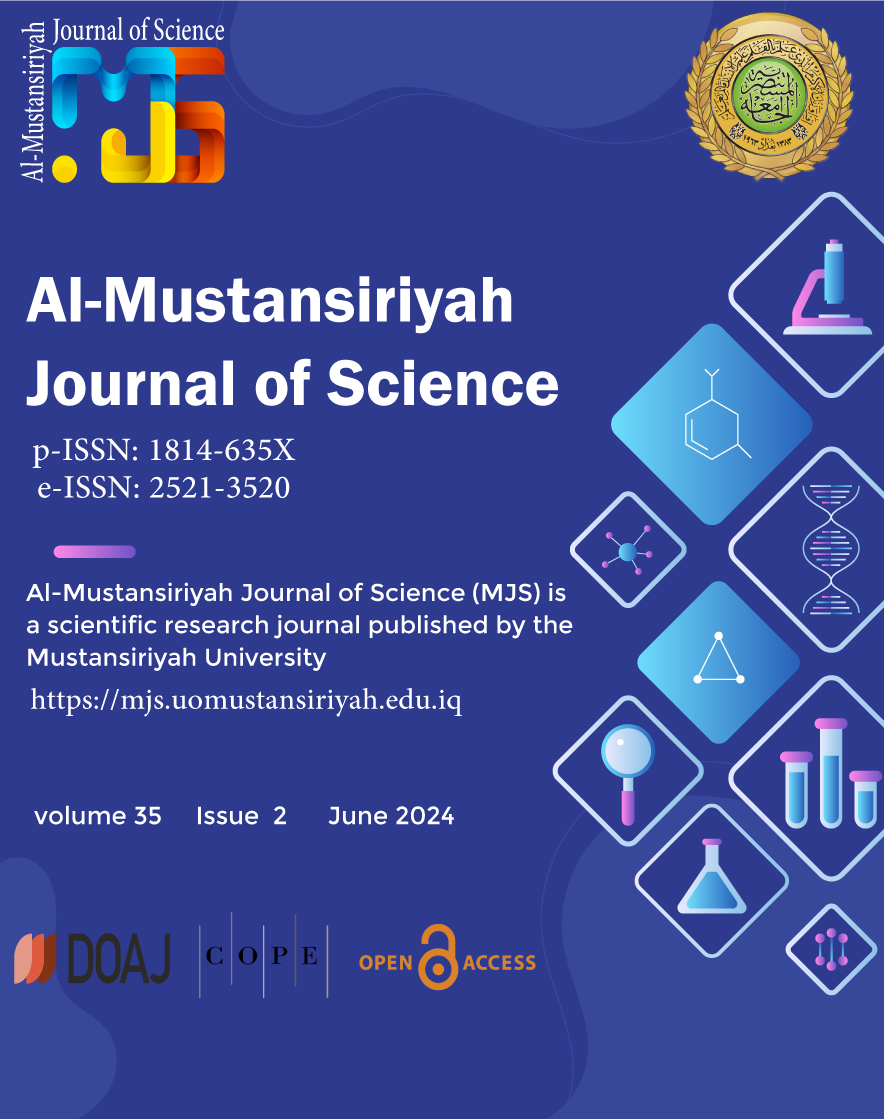Relationship between Snow and Temperature over Some Iraqi Meteorological Stations
DOI:
https://doi.org/10.23851/mjs.v35i2.1481Keywords:
Temperature, Snow albedo, Snow density, ECMWF, Climate changeAbstract
Background: Snow forms when tiny ice crystals in clouds stick together to become snowflakes. If enough crystals stick together, they become heavy enough to fall to the ground. Where background includes Precipitation falls as snow when the air temperature is below 2 °C (275.15 K). The falling snow does begin to melt as soon as the temperature rises above freezing, but as the melting process begins, the air around the snowflake is cold. Objective: It is a myth that it needs to be below 0 °C (273.15) K to snow. In Iraq, the heaviest snowfalls tend to occur when the air temperature is between (273.15-275.15) K (0-2) °C. Methods: The data for this study, which includes Temperature (T), Snow Albedo (SA), and Snow Density (SD) as monthly-daily mean, taken from the European Center for Medium-Range Weather Forecasts (ECMWF) for fifteen years from 2008 to 2022 for several selected stations over northern Iraq. The method was to take the monthly rates of snow density, snow albedo, and temperature for the stations of Erbil, Sulaymaniyah, Zakho, Dohuk, and Amadiyah, and the type of relationship and strength of the connection between them was also known. Results: The study found an inverse relationship between snow albedo and snow density across the selected stations, indicating that an increase in snow density leads to a decrease in snow albedo. Notably, Duhok City exhibited the strongest relationship between snow albedo and density, with a regression coefficient of 0.9699 compared to other regions. Conclusions: This study highlights the complex relationship between snow albedo and density in northern Iraq. The strong correlation observed in Duhok City suggests the importance of further research to understand the factors influencing snow properties in this region.
Downloads
References
B. Zhou, Y. Li, and K. Zhu, "Improved length scales for turbulence kinetic energy-based planetary boundary layer scheme for the convective atmospheric boundary layer," Journal of Atmospheric Sciences, vol. 77, no. 7, pp. 2605-2626, 2020.
H. M. Azeez, M. H. Khalafand, E. M. Degan, and S. M. Robaa, "Designing cloud chamber for simulate the microphysics processes in the formation of ice crystals," Al-Mustansiriyah Journal of Science, vol. 34, no. 2, p. 12, 2023.
M. Wahiduzzaman and A. Yeasmin, "A kernel density estimation approach of north indian ocean tropical cyclone formation and the association with convective available potential energy and equivalent potential temperature," Meteorology and Atmospheric Physics, vol. 132, no. 5, pp. 603-612, 2020.
Y. Noh, "Improvement of the k-profile model for the planetary boundary layer based on large eddy simulation data," Boundary-layer meteorology, vol. 107, no. 2, pp. 401-427, 2003.
O. T. Al-Taai and Z. S. Muhammad, "Calculating the monthly frequency for cloud cover in baghdad station," Al-Mustansiriyah Journal of Science, vol. 29, no. 2, p. 12, 2018.
P. Bogenschutz, "Unified parameterization of the planetary boundary layer and shallow convection with a higherorder turbulence closure in the community atmosphere model: Single-column experiments," Geoscientific Model Development, vol. 5, no. 6, pp. 1407-1423, 2012.
L. Xu and P. Dirmeyer, "Snow-atmosphere coupling strength part ii: Albedo effect versus hydrological effect," Journal of Hydrometeorology, vol. 14, no. 2, pp. 404-418, 2013.
C. Musacchio, G. Coppa, and A. Merlone, "An experimental method for evaluation of the snow albedo effect on near‐surface air temperature measurements," Meteorological Applications, vol. 26, no. 1, pp. 161-170, 2019.
Z. M. Abbood and O. T. Al-Taai, "Data analysis for cloud cover and rainfall over baghdad city, iraq," Plant Archives, vol. 20, no. 1, pp. 822-82, 2020.
P. Tremblin, "Advection of potential temperature in the atmosphere of irradiated exoplanets: A robust mechanism to explain radius inflation," The Astrophysical Journal, vol. 841, no. 1, p. 30, 2017.
Z. M. Abbood and O. T. Al-Taai, "Calculation of absorption and emission of thermal radiation by clouds cover," ARPN Journal of Engineering and Applied Sciences, vol. 13, no. 24, pp. 9446-9456, 2018.
O. F. Khayoon and O. T. Al-Taai, "Severe meteorological factors affecting civil aviation flights at iraqi airports," Al-Mustansiriyah Journal of Science, vol. 33, no. 4, pp. 15-26, 2022.
O. T. Al-Taai, S. A. Hashim, W. G. Nassif, and Z. M. Abbood, "Interference between total solar radiation and cloud cover over baghdad city," Journal of Physics: Conference Series, vol. 2114, no. 1, p. 012 070, 2021.
O. T. Al-Taai, Z. M. Abbood, and J. H. Kadhum, "Determination stability potential energy of thunderstorms for some severe weather forecasting cases in baghdad city," Journal of Green Engineering, vol. 11, no. 1, pp. 779-794, 2021.
Downloads
Key Dates
Received
Revised
Accepted
Published
Data Availability Statement
All relevant data is included in the paper.
Issue
Section
License
Copyright (c) 2024 Zainab M. Abbood, Yasmin Q. Tawfeek, Salwa S. Naif, Osama T. Al-Taai, Ahmed S. Hassan, Monim H. Al-Jiboori, Zeinab Salah

This work is licensed under a Creative Commons Attribution 4.0 International License.
(Starting May 5, 2024) Authors retain copyright and grant the journal right of first publication with the work simultaneously licensed under a Creative Commons Attribution (CC-BY) 4.0 License that allows others to share the work with an acknowledgement of the work’s authorship and initial publication in this journal.














